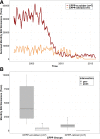Sulfur dioxide reduction at coal-fired power plants in North Carolina and associations with preterm birth among surrounding residents
- PMID: 37064422
- PMCID: PMC10097570
- DOI: 10.1097/EE9.0000000000000241
Sulfur dioxide reduction at coal-fired power plants in North Carolina and associations with preterm birth among surrounding residents
Abstract
Coal-fired power plants (CFPP) are major contributors of air pollution, including the majority of anthropogenic sulfur dioxide (SO2) emissions, which have been associated with preterm birth (PTB). To address a 2002 North Carolina (NC) policy, 14 of the largest NC CFPPs either installed desulfurization equipment (scrubbers) or retired coal units, resulting in substantial reductions of SO2 air emissions. We investigated whether SO2 air emission reduction strategies at CFPPs in NC were associated with changes in prevalence of PTB in nearby communities.
Methods: We used US EPA Air Markets Program Data to track SO2 emissions and determine the implementation dates of intervention at CFPPs and geocoded 2003-2015 NC singleton live births. We conducted a difference-in-difference analysis to estimate change in PTB associated with change in SO2 reduction strategies for populations living 0-<4 and 4-<10 miles from CFPPs pre- and postintervention, with a comparison of those living 10-<15 miles from CFPPs.
Results: With the spatial-temporal exposure restrictions applied, 42,231 and 41,218 births were within 15 miles of CFPP-scrubbers and CFPP-retired groups, respectively. For residents within 4-<10 miles from a CFPP, we estimated that the absolute prevalence of PTB decreased by -1.5% [95% confidence interval (CI): -2.6, -0.4] associated with scrubber installation and -0.5% (95% CI: -1.6, 0.6) associated with the retirement of coal units at CFPPs. Our findings were imprecise and generally null-to-positive among those living within 0-<4 miles regardless of the intervention type.
Conclusions: Results suggest a reduction of PTB among residents 4-<10 miles of the CFPPs that installed scrubbers.
Copyright © 2023 The Authors. Published by Wolters Kluwer Health, Inc. on behalf of The Environmental Epidemiology. All rights reserved.
Conflict of interest statement
The authors declare that they have no conflicts of interest with regard to the content of this report.
Figures




Similar articles
-
North Carolina's Changing Energy Generation Profile and Reductions in Key Air Pollutants, 2000-2019.N C Med J. 2022 Jul-Aug;83(4):304-310. doi: 10.18043/ncm.83.4.304. N C Med J. 2022. PMID: 35817451
-
Costs and Benefits of Installing Flue-Gas Desulfurization Units at Coal-Fired Power Plants in India.In: Mock CN, Nugent R, Kobusingye O, Smith KR, editors. Injury Prevention and Environmental Health. 3rd edition. Washington (DC): The International Bank for Reconstruction and Development / The World Bank; 2017 Oct 27. Chapter 13. In: Mock CN, Nugent R, Kobusingye O, Smith KR, editors. Injury Prevention and Environmental Health. 3rd edition. Washington (DC): The International Bank for Reconstruction and Development / The World Bank; 2017 Oct 27. Chapter 13. PMID: 30212107 Free Books & Documents. Review.
-
Health and air quality benefits of policies to reduce coal-fired power plant emissions: a case study in North Carolina.Environ Sci Technol. 2014 Sep 2;48(17):10019-27. doi: 10.1021/es501358a. Epub 2014 Aug 14. Environ Sci Technol. 2014. PMID: 25046689
-
Mercury speciation and mass distribution of coal-fired power plants in Taiwan using different air pollution control processes.J Air Waste Manag Assoc. 2021 May;71(5):553-563. doi: 10.1080/10962247.2020.1860158. Epub 2021 Feb 17. J Air Waste Manag Assoc. 2021. PMID: 33284737
-
Exposure to air pollution from coal-fired power plants and impacts on human health: a scoping review.Rev Environ Health. 2025 Mar 6. doi: 10.1515/reveh-2024-0173. Online ahead of print. Rev Environ Health. 2025. PMID: 40042098 Review.
Cited by
-
Long-term ambient sulfur dioxide exposure during gestation and preterm birth in North Carolina, 2003-2015.Atmos Environ (1994). 2024 Sep 15;333:120669. doi: 10.1016/j.atmosenv.2024.120669. Epub 2024 Jun 25. Atmos Environ (1994). 2024. PMID: 39219580
References
-
- Bi X. “Cleansing the air at the expense of waterways?” Empirical evidence from the toxic releases of coal-fired power plants in the United States. J Regul Econ. 2017;51:18–40.
-
- Massetti EB. Environmental Quality and the U.S. Power Sector: Air Quality, Water Quality, Land Use and Environmental Justice. Oak Ridge National Lab. (ORNL), Oak Ridge, TN (United States). Building Technologies Research and Integration Center (BTRIC); 2017.
-
- Wang Z, Cowan EA, Seramur KC, et al. . Legacy of coal combustion: widespread contamination of lake sediments and implications for chronic risks to aquatic ecosystems. Environ Sci Technol. 2022;56:14723–14733. - PubMed
-
- U.S. EPA. Integrated Science Assessment (ISA) for Sulfur Oxides – Health Criteria (Final Report, Dec 2017). U.S. Environmental Protection Agency, Washington, DC, EPA/600/R-17/451, 2017. Available at: https://cfpub.epa.gov/ncea/isa/recordisplay.cfm?deid=338596. Accessed 26 December 2022.
-
- U.S. EPA. Integrated Science Assessment (ISA) for Particulate Matter (Final Report, Dec 2019). U.S. Environmental Protection Agency, Washington, DC, EPA/600/R-19/188, 2019. Available at: https://cfpub.epa.gov/ncea/isa/recordisplay.cfm?deid=347534. Accessed 26 December 2022.
Grants and funding
LinkOut - more resources
Full Text Sources
Research Materials
